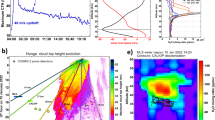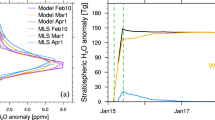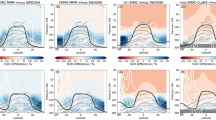Abstract
GREAT interest has been aroused by the possibility that a fleet of supersonic transports (SST) flying in the stratosphere would deposit sufficient water vapour to increase the average global concentration by about 7%, from 3 p.p.m. to 3.2 p.p.m. (ref. 1). The injection of this water vapour would result in a small decrease in stratospheric temperature according to Manabe and Wetherald2,3. Perhaps more significantly, it could decrease the concentration of ozone in the lower stratosphere through a series of photochemical reactions4–9.
This is a preview of subscription content, access via your institution
Access options
Subscribe to this journal
Receive 51 print issues and online access
$199.00 per year
only $3.90 per issue
Buy this article
- Purchase on Springer Link
- Instant access to full article PDF
Prices may be subject to local taxes which are calculated during checkout
Similar content being viewed by others
References
Man's Impact on the Global Environment: Assessment and Recommendations for Action, Report of the Study of Critical Environmental Problems, 73 (MIT Press, Cambridge, 1970).
Manabe, S., and Weatherald, R. T., J. Atmos. Sci., 24, 241 (1967).
Manabe, S., Science, 169, 534 (1970).
Hunt, B. G., J. Atmos. Sci., 23, 88 (1966).
Hunt, B. G., J. Geophys. Res., 71, 1385 (1966).
Leovy, C. B., J. Geophys. Res., 74, 417 (1969).
Harrison, H., Science, 170, 734 (1970).
McGrath, W., and Norrish, R., Proc. Roy. Soc., A, 254, 839 (1960).
London, J., and Park, J., in Man's Impact on the Global Environment: Assessment and Recommendations for Action Report of the Study of Critical Environmental Problems, 73 (MIT Press, Cambridge, 1970).
McDonald, J. E., Congressional Record, S3904, March 12, 1971.
Ehhalt, D. H., J. Air Poll. Control Assoc., 17, 518 (1967).
Junge, C. E., Air Chemistry and Radioactivity, International Geophysical Series (edit. by Van Miegham), 4 (Academic Press, New York, 1963).
Reiter, E. R., Atmospheric Transport Processes, Part 2, TID 25314 (Atomic Energy Commission, Washington, 1971).
Koyama, T., J. Geophys. Res., 63, 3971 (1963).
Robinson, E., and Robbins, R. C., Sources, Abundance and Fate of Gaseous Atmospheric Pollutants (Stanford Research Institute, 1968) (prepared for American Petroleum Institute, New York).
Rasmussen, R. A., and Went, F. W., Proc. Nat. Acad. Sci., 53, 215 (1965).
Stephens, D. R., and Burleson, F. R., 62nd Annual Meeting, Air Pollution Control Association (June 22 to 26, 1969).
Cavanaugh, L. A., Schadt, C. F., and Robinson, E., Environ. Sci. Technol., 3, 251 (1969).
Swinnerton, J. W., Linnenbom, V. J., and Cheek, C. H., Environ. Sci. Technol., 3, 836 (1969).
Bainbridge, A. E., and Heidt, L. E., Tellus, 18, 221 (1966).
Kyle, T. G., Murcray, D. G., Murcray, F. H., and Williams, W. J., J. Geophys. Res., 74, 3421 (1969).
Scholz, T. G., Ehhalt, D. H., Heidt, L. E., and Martell, E. A., J. Geophys. Res., 75, 3049 (1970).
Reed, R. J., and German, K. E., Mon. Weather Rev., 93, 316 (1965).
Chatham, G. N., and Huddle, F. P., The Supersonic Transport, Library of Congress, Congressional Research Service (71-78 SP) (February 26, 1971).
Daniels, G. M., Astronautics and Aeronautics, 8, 22 (1970).
Newell, R. E., Nature, 226, 70 (1970).
Cadle, R. D., and Powers, J. W., Tellus, 18, 176 (1966).
Robinson, E., and Robbins, R. C., in Global Effects of Environmental Pollution (edit. by Singer, S. F.), 50 (Reidel, Dordrecht, and Springer-Verlag, New York, 1970).
Jaffee, L. S., ibid., 34.
Johnston, H., Science, August 6, 1971.
Lateef, M. A., Mon. Weather Rev., 96, 286 (1968).
Reed, R. J., and Vlcek, C. L., J. Atmos. Sci., 26, 163 (1969).
ZoBell, C. E., Advan. Enzymol., 10, 443 (1950).
Inman, R. E., Ingersoll, R. B., and Levy, E. A., Science, 172, 1229 (1971).
Abeles, F. B., Craker, L. E., Forrence, L. E., and Leather, G. R., Science, 173, 914 (1971).
Author information
Authors and Affiliations
Rights and permissions
About this article
Cite this article
SINGER, S. Stratospheric Water Vapour Increase due to Human Activities. Nature 233, 543–545 (1971). https://doi.org/10.1038/233543a0
Received:
Revised:
Issue Date:
DOI: https://doi.org/10.1038/233543a0
This article is cited by
Comments
By submitting a comment you agree to abide by our Terms and Community Guidelines. If you find something abusive or that does not comply with our terms or guidelines please flag it as inappropriate.



